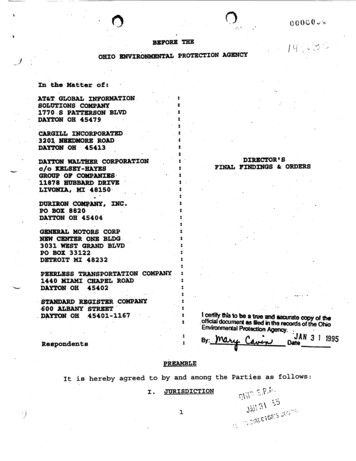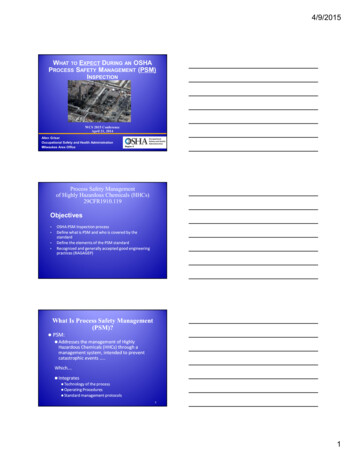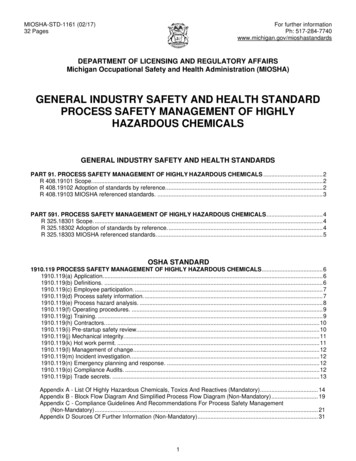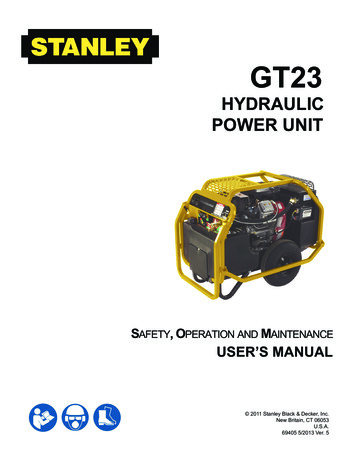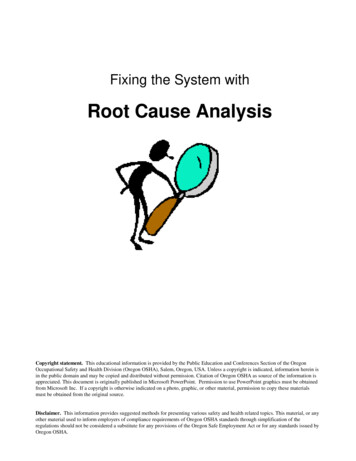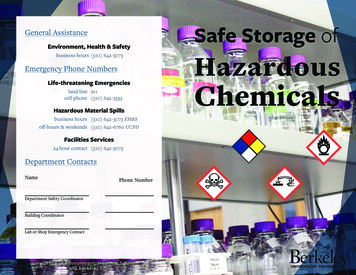
Transcription
General AssistanceEnvironment, Health & Safetybusiness hours (510) 642-3073Emergency Phone NumbersLife-threatening Emergenciesland line 911cell phone (510) 642-3333Hazardous Material Spillsbusiness hours (510) 642-3073 EH&Soff-hours & weekends (510) 642-6760 UCPDFacilities Services24 hour contact (510) 642-3073Department ContactsNamePhone NumberDepartment Safety CoordinatorBuilding CoordinatorLab or Shop Emergency ContactOffice of Environment, Health & Safetyehs.berkeley.eduSafe Storage ofHazardousChemicals
ContentsPageIntroduction11.01Take Inventory of Your Chemicals2.0 Label Your Chemicals23.0 Segregate Incompatibles53.1 Common Incompatibles74.0 Basic Storage Requirements95.0 Chemical Storage Guide: Individual Hazardsand Mixed Hazards115.1 Flammables and Combustibles145.2 Corrosives175.3 Toxics195.4 Highly Toxics205.5 Oxidizers225.6 Compressed Gases245.7 Cryogens265.8 Pyrophorics (Air Reactives)285.9 Water Reactives295.10 Explosive and Potentially Explosive305.11 Peroxide Forming Chemicals34
1
IntroductionThe safe storage of hazardous chemicals is an essential partof an environmental, health, and safety program. Chemicalstorage facilities must meet certain minimum standards tosatisfy diverse regulations, such as those of Cal/OSHA, thelocal sanitary district, and the California Fire Code. Thismanual provides guidelines to help you meet these standards.In addition, laboratories and work areas on campus mustobserve several requirements that incorporate safe storage: Keeping an up-to-date chemical inventory Maintaining a chemical hygiene plan and documenting stafftraining Conducting annual self-inspectionsEH&S provides more information on the above programs at itswebsite http://ehs.berkeley.edu.The five sections of this brochure cover the main elements ofa safe chemical storage program:SectionInformation1How to Maintain an Accurate Inventory ofHazardous ChemicalsIllustrations by Oruc Cakmakli22Proper Chemical Labeling3Segregating Incompatible Chemicals4Providing Basic Storage Needs5Storing Chemicals according to their HazardousCharacteristic3
1.0 Take Inventory of Your Chemicals2.0 Label Your ChemicalsSafe storage begins with an up-to-date inventory of hazardouschemicals that can be used to apprise personnel of the dangersin a laboratory, shop, or work area. An accurate inventoryis also necessary if emergency responders are to respondeffectively to a fire or chemical release in the area. The campuscan be fined if it does not provide an inventory to emergencyresponse personnel and appropriate regulatory agencies.All hazardous chemicals must be clearly labeled for thebenefit of current users, emergency personnel, and futureusers. Unknown chemicals can be expensive to dispose of.Make sure all labels are legible and in good condition. Repairor replace damaged or missing labels.The Office of Environment, Health & Safety (EH&S)coordinates the collection of chemical inventories for thecampus. Submit your inventory to EH&S annually. Alsosubmit one whenever the maximum amount listed for aparticular chemical changes by more than 50 percent oryou obtain a chemical that was previously not reported.Immediately notify EH&S if a laboratory or other area has beencleaned out or a new laboratory has started up or moved.The annual review of your chemical inventory is a primeopportunity to clean out unwanted chemicals. Your unwantedchemicals will either be picked up and disposed of or collectedfor reuse through the campus Chemical Exchange Program(CHEX). Visit the EH&S web site (http://ehs.berkeley.edu) forFact Sheets about CHEX and disposal of unwanted hazardousmaterials.Manufacturers’ LabelsCal/OSHA requires that manufacturers provide labels withthe following information: contents of the container physical and health hazard information name, address, and emergency phone number of themanufacturer or other responsible partyOriginal manufacturers’ labels must not be removed ordefaced. Material Safety Data Sheets (MSDSs) must beaccessible to anyone working with these chemicals. Electronicformat MSDSs are available from the EH&S web site at http://ehs.berkeley.edu. The MSDS may also provide useful storageinformation.Your Own LabelsHazardous chemicals that are not in the manufacturer’soriginal container (e.g., working solutions prepared in thelab) must, at a minimum, be labeled with the contents ofthe container. If the contents arehazardous, attach a label indicatingthe hazard to warn individuals in thework area. It is not necessary to labelcontainers that will be used temporarily(during one work shift) and are underyour immediate control.Keep an extra copy of yourinventory handy at a centrallocation.4Label your chemicals.5
3.0 Segregate IncompatiblesChemical FamiliesMaterials should always be segregated and stored accordingto their chemical family or hazard classification. Do not storechemicals alphabetically unless they are compatible! The mostcommon hazard classes include:classes. Incompatible chemicals within the same hazard classshould also be separated from one another. For example, bothnitric and perchloric acids are incompatible with organic acids(such as acetic acid) and should not be stored together.Most labs have limited space, but the following priorities mayhelp you decide how to store the chemicals. Do not store chemicals alphabetically unless they arecompatible. Store flammable liquids in approved safety containers inflammable storage cabinets. Do not store anything butflammable or combustible liquids in these cabinets. Segregate acids from bases. Segregate most organic acids from oxidizing mineral acids. Keep oxidizers away from other chemicals, especiallyflammables, combustibles, and toxic materials. Keep corrosives away from substances that they may reactwith and release corrosive, toxic, or flammable vapors. flammables/combustibles corrosive acids corrosive bases toxics highly toxics oxidizers compressed gases cryogens pyrophorics water reactives explosivesAccidental contact between incompatible chemicals can resultin a fire, an explosion, the formation of highly toxic and/orflammable substances, or other potentially harmful reactions:Oxidizers mixed with flammable solvents can cause afire. Acids mixed with metal dust can produce flammablehydrogen gas.Alphabetical storage can bring incompatibles together. Forexample, if chromic acid (an oxidizing acid) and chromiumpowder (a combustible metal) were stored together and anaccident broke their containers, the chemicals could mixand react with explosive violence.Multiple Hazard ClassesMany chemicals belong to more than one chemical family orhazard class. In such cases, all storage rules must be strictlyobserved. For example, acetic acid is both a corrosive acid anda combustible liquid. It must be stored away from corrosivebases, such as sodium hydroxide, and also from oxidizing acids,such as nitric acid.For More InformationFor more specific information, use the storage guidelines thatfollow. You can obtain labels and material safety data sheets(MSDSs) from the manufacturer, your department, or EH&S.MSDSs provide information on chemical compatibility.Segregate FamiliesEach chemical family should be separated from all otherchemical families by an approved non-combustible partition orby a distance of twenty feet. Ideally, each hazard class wouldbe kept in a cabinet or on a shelf segregated from other hazard67
3.1 Common IncompatiblesChlorineammonia, acetylene, butadiene,benzene, other petroleumfractions, hydrogen, sodiumcarbide, turpentine, finelydivided powdered metalsacidsDo not store incompatible chemicals in close proximity to eachother. In an earthquake, fire, or other spill, they could mix andreact violently and/or release poisonous gas.Laboratory MaterialIncompatible withAlkali metals like calcium, water, carbon dioxide, carbontetrachloride, other chlorinatedpotassium, and sodiumAcetic AcidAcetoneAcetyleneAmmonia, AnhydrousAmmonium NitrateAnilineBromineChloratesChromic Acidhydrocarbonschromic acid, nitric acid,hydroxyl-containingcompounds, ethylene glycol,perchloric acid, peroxides,permanganatesconcentrated sulfuric or nitricacid mixturescopper (tubing), halogens, silver,mercury, and their compoundsmercury, halogens, calciumhypochlorite, hydrogen fluorideacids, metal powders,flammable liquids, chlorates,nitrates, sulfur, finely dividedorganics or combustiblesnitric acid, hydrogen peroxideammonia, acetylene, butadiene,butane, hydrogen, sodiumcarbide, turpentine, finelydivided metalsammonium salts, acids, metalpowders, sulfur, carbon, finelydivided organics, combustiblesacetic acid, naphthalene,camphor, alcohol, glycerine,turpentine, other flammableliquids or combustiblematerials8CyanidesHydrogen Peroxidecopper, chromium, iron, mostmetals or their respectivesalts, flammable liquids orcombustible materials, aniline,nitro-methanenitric acid, oxidizing gasesHydrogen SulfideHydrocarbons (general)halogens, chromic acid, sodiumperoxideacetylene, ammonia, chlorineIodineMercuryNitric Acidacetylene, ammonia, lithiumacetic, chromic, andhydrocyanic acids, aniline,carbon, hydrogen sulfide,flammable material, readilynitrated substancesoils, grease, hydrogen;flammable materialssilver, mercury, chlorites,strong oxidizersacetic anhydride, bismuth andits alloys, alcohol, paper, wood,other organic materialsglycerine, ethylene glycol,benzaldehyde, sulfuric acidany oxidizable substancesOxygenOxalic AcidPerchloric AcidPotassium PermanganateSodium PeroxideSulfuric Acidchlorates, perchlorates,permanganates9
4.0 Basic Storage RequirementsStorage CabinetsThe following basic storage requirements apply to all hazardouschemicals. Refer to the “Chemical Storage Guide” sectionsof this brochure for additional requirements that apply tochemicals in a specific hazard class (e.g., flammables andcorrosives).Label cabinets with the hazard class of the chemicals.Storage Area Requirements Label storage areas according to the type of chemical familyor hazard classification found there. Inspect storage areas at least annually, as required by Cal/OSHA. Keep aisles, hallways, doorways, exits, and entryways clear. Keep storage areas well lit, appropriately ventilated, and at aconsistent, cool temperature. Eliminate ignition sources such as open flames, heat sources,or direct sunlight. Keep emergency equipment such as fire extinguishers handyand in good working order. Confine chemical storage areas so that leaks or spills arecontrolled. Prevent chemicals from running down sink, floor,or storm water drains. Clean up spills and drips immediately.Storage Don’ts Don’t store chemicals in a sink or fume hood, except forcertain toxic gases that are so dangerous they can only bestored in a gas cabinet or fume hood. Don’t store chemicals on dirt or grass, near a creek or stormdrain entrance, where they could contaminate the environment.Use only approved storage cabinets. Never alter a flammablestorage cabinet unless directed to do so by EH&S.Storage ShelvesShelves should be level, stable, and secured to the wall oranother stable surface.In case of an earthquake, shelves should have raised edges orrim guards (minimum height of 2 inches) to prevent containersfrom falling. Use bungee cords for added security.Shelves should be kept free of chemical contamination anddust.Shelves should be located away from direct sun, flame, and heatsources.Containers should not protrude over shelf edges.Store large bottles/containers no higher than 2 feet from thefloor. Store corrosives on lower shelves.Storage ContainersKeep containers closed unless you are dispensing a chemical oradding to the container. Never store a container open with afunnel in it.Provide secondary containment for liquids in containers largerthan 1 gallon in size. Dishpans or polyethylene trays work well.Use approved containers for flammable solvents. Don’t store chemicals on the floor, window ledges, orbalconies.1011
5.0 Chemical Storage Guide:Individual Hazards and Mixed HazardsSections 5.1 through 5.11 provide basic storage guidelines forthe most common hazard classes. Each section describes thecharacteristics of the hazard class (consistent with CaliforniaFire Code). It includes common examples of laboratoryand non-laboratory chemicals and provides basic storagerequirements and precautions. Note: These examples donot constitute a full list, and the laboratory/non-laboratoryclassifications may not strictly apply.Please note that many chemicals have multiple hazardclassifications. Consequently, you may need to consultseveral storage guideline sections to determine how to storea hazardous chemical safely. For example, acetic acid is acorrosive acid and also a combustible liquid. Therefore, youneed to follow section 5.1 (flammables and combustibles) andsection 5.2 (corrosives). You may also call EH&S for help.Federal and state regulations may require a Risk ManagementPlan for certain highly hazardous chemicals, depending onthe amount stored. EH&S periodically reviews your chemicalinventory and will notify you if there is a concern. It is aprudent practice to maintain the lowest possible quantities ofhighly hazardous chemicals.The capital letters in parenthesis used in sections 5.1– 5.11 thatfollow the chemical examples indicate that the chemical has anadditional hazardous characteristic other than the one beingdiscussed. Refer to the appropriate storage guideline section inthis brochure for information and follow its directives as well.NFPA Chemical Hazard Identification SystemEach hazard class section on the following pages includes twochemical examples illustrated with National Fire ProtectionAssociation (NFPA) diamond symbols that rate the degree ofhealth, flammability, reactivity, and special hazards of the12chemicals discussed. Hazards are rated from 0 for minimalhazard to 4 for severe hazard.The degree of hazard is often dependent upon the physicalstate of the chemical as well. For example, a flammable gaswill pose a more significant immediate safety threat uponrelease than a liquid that has the same flash point.The NFPA Health Hazard rates the effect of short-termexposure to a chemical by physical contact, eye and skinabsorption, or inhalation. A highly toxic chemical witha health hazard rating of 4 could be lethal on very ity(Yellow)Special(White)The NFPA Flammability Hazard rates the ease with which achemical will ignite from exposure to a spark, open flame,or high temperature. A flammable or pyrophoric chemicalwith a flammability rating of 4 could readily ignite at roomtemperature.The NFPA Reactivity Hazard rates a chemical’s thermalinstability, potential for hazardous reaction with water, orsensitivity to friction or shock. A highly unstable chemical,such as an explosive with a reactivity rating of 4, could readilydetonate if exposed to localized thermal or mechanical shockat normal temperatures and pressures.The NFPA Special Hazards include W (to indicate a waterreactive chemical that could react violently or explosively uponcontact with water) and OX (to indicate an oxidizer that couldignite combustible or flammable material upon contact).13
Non-Laboratory Chemicals5.1 Flammables and CombustiblesCharacteristicsThese chemicals are easily ignited andmay present a serious fire and explosionhazard. Flammable liquids have a flashpoint below 100 F. Combustible liquidshave a flash point of 100 F to 200 F.Flammable solids have an ignitiontemperature below 212 F. Flammablesolids include finely divided solidmaterials which, when dispersed in air, could ignite. Otherclasses of chemicals with a high fire hazard include oxidizers(section 5.5), pyrophoric chemicals (section 5.8), and waterreactive chemicals (section 5.9).Laboratory ChemicalsFlammable SolidsFlammable Liquidsnaphthalene (HT)finely divided metal (e.g.,aluminum, cadmium,chromium, titanium, zinc) (P)alcohols ‑ methanol, ethanolesters ‑ ethyl acetateethers ‑ diethyl etherketones ‑ acetone, cyclohexaneFlammable GasesCombustible Liquidshydrogenmethaneacetic acid (CA)cumenephenol (CA, T)propionic acid (CA)141110glycerineethyl ether14Flammable SolidsFlammable Liquidsmoth balls (HT)(containing naphthalene)calcium carbide (WR)gasolinelighter fluidpaint thinnerFlammable GasesCombustible Liquidsacetyleneantifreezediesel fuelengine oilAdditional hazardous characteristics: CA–Corrosive acid; HT–Highlytoxic; P–Pyrophoric; T–Toxic; WR–Water reactiveStorage LimitsCalifornia Fire Code regulations limit the quantityof flammable liquids stored in research and teachinglaboratories on the Berkeley campus.Quantity Limits outside Flammable Storage CabinetsA maximum of ten (10) gallons of flammable liquids may bestored outside a flammable storage cabinet.Quantity Limits within Flammable Storage CabinetsFlammable liquids stored in approved cabinets withinlaboratories or classrooms shall not exceed sixty (60) gallons.Maximum Container Capacity The capacity of glass containers shall not exceed one (1)gallon. The capacity of all other containers (including safety cans)shall not exceed two (2) gallons.See the Fact Sheet on the storage of flammable liquids athttp://ehs.berkeley.edu. If you need additional information,please contact the Campus Fire Marshal at 642-4409.15
Storage Precautions for Flammables andCombustibles5.2 CorrosivesCharacteristicsKeep flammables away from all ignition sources: open flames,hot surfaces, direct sunlight, spark sources.Strong acids and bases can destroyhuman tissue and corrode metals.Acids and bases are incompatible withone another and may react with manyother hazard classes.Store flammables separate from other hazard classes,especially oxidizers and toxics.Separate flammable gases from oxidizing gases with anapproved non-combustible partition or by a distance of 20 feet.Store flammable liquids in approved safety containers orcabinets.In instances where static electricity may accumulate andignite flammable vapors, ground and bond flammable liquidcontainers.Keep a fire extinguisher (appropriate for the hazard) readilyavailable and make sure anyone who may need to use it isproperly trained.Keep flammable liquidsthat require cold storagein laboratory-safeflammable materialrefrigerators or freezersto avoid ignition of thematerials by sparks orstatic electricity. See theFact Sheet about storageof hazardous materials infreezers and refrigeratorsat http://ehs.berkeley.edu.Laboratory ChemicalsAcidsBasesOrganic Acidsacetic acid (C)citric acid ( C )formic acid (C, T)oxalic acid (T)ammmonium hydroxide (T)calcium hydroxidepotassium hydroxide (T, WR)sodium hydroxide (T, WR)tri-sodium phosphate (T)Inorganic Oxidizing Acidschromic acid (O, T)nitric acid (HT, O)perchloric acid (O, PEC)sulfuric acid (O, T, WR)40OX0nitric acid301Wsodium hydroxideInorganic Non-Oxidizing Acidshydrochloric acidphosphoric acidNon-Laboratory ChemicalsAcidsmuriatic acid (containshydrochloric acid)Retrofitting nonlaboratory saferefrigerators for use withflammables is prohibited.Basesdrain declogger (containingsodium hydroxide)wall cleaner (containing trisodium phosphate)Additional hazardous characteristics: C–Combustible liquid or solid;HT–Highly toxic; O–Oxidizer; PEC–Potentially explosive chemical;T–Toxic; WR–Water reactive1617
Storage Precautions for Corrosives5.3 ToxicsCharacteristicsSegregate acids from bases. Segregate inorganic oxidizingacids (e.g., nitric acid) from organic acids (e.g., acetic acid),flammables, and combustibles.Overexposure to toxic chemicals cancause injury or death. Toxics arechemi-cals with a lethal dose (LD50)of more than 50 and less than 500milligrams per kilogram body weightor a lethal concentration (LC50) in airof more than 200 and less than 1,000parts per million.Segregate acids from chemicals that could generate toxicgases upon contact (e.g., sodium cyanide and iron sulfide).Segregate acids from water reactive metals such as sodium,potassium, and magnesium.Use tight-fitting goggles, gloves,and closed-toe shoes while handlingcorrosives.Store solutions of inorganic hydroxidesin polyethylene containers.Laboratory ChemicalsSolidsacrylamidecadmium chloridepotassium fluoride (CA)Liquidsaniline (C)chlordanephenol (C, CA)Store corrosives on lower shelves, atleast below eye level and in compatiblesecondary containers.Non-Laboratory ChemicalsDo not store corrosives on metal shelves. Althoughventilation helps, chemicals will still corrode the shelves.Store containers in plastic tubs or trays as secondarycontainment.Additional hazardous characteristics:C - Combustible liquid; CA - Corrosive AcidIf you notice powder deposits, discoloration, andcrystallization around the cap of a container, particularly anoxidizing acid, contact EH&S immediately. The material maybe potentially explosive.Follow the special handling and use procedures forhydrofluoric acid (See the Fact Sheet about hydrofluoric acidat http://ehs.berkeley.edu). Keep calcium gluconate availableas an antidote.Have spill control pillows or neutralizing agents available incase of a spill. These may be purchased from safety gen fluoride (CA)vinyl bromideLiquidscopper sulfateStorage Precautions for ToxicsSegregate toxics from other hazard classesand store in a cool, well ventilated area, awayfrom light and heat.403hydrogen sulfide230phenolContainers should be tightly sealed to minimize exposure topersonnel and contamination of other chemicals.Manage toxic gases, highly toxic gases, and pyrophoric gases inaccordance with the campus Toxic Gas Program requirements.Contact EH&S for specifics, or print out the Fact Sheet aboutthe campus Toxic Gas Program at http://ehs.berkeley.edu.19
5.4 Highly ToxicsCharacteristicsThese chemicals can cause seriousinjury or death at low concentrations.Highly toxics are chemicals with alethal dose (LD50) of less than orequal to 50 milligrams per kilogrambody weight or a lethal concentration(LC50) in air of less than or equal to200 parts per million.Laboratory ChemicalsSolidsLiquidsGasesarsenic saltsacroleindiborane (P, WR)calium cyanidehydrocyanic acid (CA, F) fluorine (CA, O, WR)organic mercury nicotine (C)nitrogen dioxide (O)compounds43WThe California Fire Code limits the amount of highly toxicgases to 20 cubic feet per laboratory or storage area.Manage toxic gases, highly toxic gases, or pyrophoricgases in accordance with the campus Toxic Gas Programrequirements. See the Fact Sheet about the campus ToxicGas Program at http://ehs.berkeley.edu. Contact EH&S forspecifics.Containers should be tightly sealed to minimize exposure topersonnel and avoid contamination from other chemicals.Do not eat, drink, or apply cosmetrics where highly toxicchemicals are handled.044The California Fire Code limits the aggregate amount ofhighly toxic solids and liquids to 10 pounds per laboratory orstorage area.1potassium dichromatediboraneAdditional hazardous characteristics: C–Combustible; CA–Corrosiveacid; F–Flammable; O–Oxidizer; P–Pyrophoric; WR–Water reactiveStorage Precautions for Highly ToxicsMaintain the lowest possible quantities of highly toxics.Segregate highly toxic chemicals from other hazard classesand store in an area that is cool, well ventilated, and awayfrom light and heat.Use highly toxic chemicals in a designated area or laboratory.Highly toxic chemicals that produce fumes or dust shouldalways be handled within a chemical fume hood.Handle highly toxic chemicals in a chemical fume hood.2021
5.5 OxidizersStorage Precautions for OxidizersCharacteristicsOxidizers are a fire hazard. Theywill readily decompose under certainconditions to yield oxygen or react topromote or initiate the combustion offlammable or combustible materials.Segregate oxidizers from flammable and combustiblematerials (paper, wood). See Flammables and Combustibles(section 5.1).Segregate oxidizers from reducing agents (zinc, alkalinemetals, formic acid).Segregate inorganic oxidizers from organic peroxides.Laboratory ChemicalsSolidsammonium nitratecalcium nitrate (T)potassium chloratepotassium nitratesodium dichromate (H, T)sodium nitrateLiquidsGasesbrominechlorine (HT)chromic acid (CA, T)fluorine (CA, HT, WR)hydrogen peroxidenitrogen dioxide (HT)nitric acid (CA, HT)oxygenperchloric acidozone (H, T)(CA, PEC)sulfuric acid (CA, T, WR)Non-Laboratory ChemicalsSolidsLiquidsOXRemember that perchloric acid, nitric acid, and hydrogenperoxide are oxidizers and must not be stored on woodenshelves or in cardboard boxes.oxygenchlorine (T)030Store in a cool, dry place. Do not store under sink.Gasesfertilizers (e.g.,bleaching agentsammonium nitrate)(e.g., hyrogenpool chemicalsperoxide,(e.g., bromine tablets)sodiumhypochlorite)01Take care not to contaminate oxidizers. Some oxidizers,such as perchloric acid, can become explosive mixtures ifcontaminated with trace amounts of organic materials ormetals. See Explosive and Potentially Explosive Chemicals(section 5.10).WOX2sulfuric acidsilver nitrateDo not store oxidizers on wood shelves. A leak could start a fire.Additional hazardous characteristics: CA–Corrosive acid; T–Toxic;HT–Highly toxic; PEC–Potentially explosive chemical; WR–Water reactive2223
5.6 Compressed GasesSecure cyclinders so they will not fall during an earthquake.CharacteristicsWhat all compressed gases havein common is the large amount ofenergy stored in the cylinder fromthe compression of the gas. Droppingor knocking over a cylinder can causethe energy to be rapidly released.It may even propel a cylinder likea rocket. Additional hazards can arise from the toxicity,flammability, corrosivity, or reactivity of the gas.Laboratory Chemicalsargonbutane (F)carbon monoxide (T)chlorine (T,O)ethylene (F)hydrogen (F)methane (F)nitrogen04acetylene (F)compressed airoxygen (O)0chlorine1Additional hazardous characteristics:F–Flammable; T–Toxic; O–Oxidizer4Keep cylinders away from heat and open flames.Leave the valve protection cap on the cylinder unless it is inuse.Never store cylinders in walk‑in freezers. The confined spacewith no ventilation poses a potential hazard.If you suspect that a cylinder is leaking, do not attempt tosniff the leak out. Apply a soap solution to the cylinder andlocate the leak by noting where the bubbles appear.OXNon-Laboratory ChemicalsAn acceptable means includes using two non-combustiblerestraints, such as chains, one restraint located approximatelyone-third of the cylinder length from the top, and the otherrestraint one-third from the bottom.Toxic gases, highly toxic gases, and pyrophoric gases must bemanaged in accordance with the campus toxic gas programrequirements. See the Fact Sheet about the campus Toxic GasProgram at http://ehs.berkeley.edu. Contact EH&S for detailsabout ventilation and quantity limitations.3acetyleneStorage Precautions for Compressed GasesSegregate incompatible gases as you would otherincompatible chemicals.Limit the quantity of compressed gas cylinders on site towhat will be used within a reasonable period of time.Secure gas cylinders adequately.Store cylinders upright.2425
Use only approved storage vessels (i.e., thermos‑likeevacuated, double-walled containers) with pressure reliefmechanisms. Non-approved vessels may explode.5.7 CryogensCharacteristicsThese materials are extremely cold(-100 C to -270 C). Upon contact withcryogenic materials, living tissue canfreeze and become brittle enough toCRYOGENSshatter. Additional hazards includerapid pressure buildup, oxygenenrichment, and asphyxiation. Rapidpressure buildup could lead to an explosion if cryogen isimproperly contained. Cryogenic liquids and gases have manyproperties and hazardous characteristics in common withcompressed gases.Laboratory Chemicalsliquid argonliquid carbon monoxide (F, T)liquid ethylene (F)liquid fluorine (CA, HT, O, WR)liquid helium30Secure containers so they will not tip over or obstruct anaisle, hallway, or corridor during an earthquake.Liquid nitrogen and liquid helium are capable of liquefyingoxygen from air. This form of oxygen enrichment can becomea strong fire or explosion hazard.Use appropriate protective equipment for handling cryogens:insulated holders for carrying vessels; eye protection, goggles,or face shields; and aprons. Use cryogenic gloves or leathergloves when handling supercold surfaces.liquid hydrogen (F)liquid methane (F)liquid nitrogenliquid oxygen (O)0300OXliquid oxygenliquid nitrogenAdditional hazardous characteristics: CA–Corrosive acid;F–Flammable; HT–Highly toxic; O–Oxidizer; T–Toxic; WR–WaterreactiveStorage Precautions for CryogensStore and handle in a well-ventilated area. When liquidcryogens are converted to the gaseous phase, they may createan oxygen deficiency. Do not use cryogens in small enclosedspaces.26Wear cryogenic or leather gloves when handling supercold surfaces.27
5.8 Pyrophorics (Air Reactives)5.9 Water ReactivesCharacteristicsSubstances that ignite spontaneouslyupon contact with air.SPONTANEOUSLYCOMBUSTIBLELaboratory ChemicalsSolidsLiquidsodium (WR)finely divided metal(e.g., aluminum,chromium, zinc)24CharacteristicsDANGEROUSLaboratory ChemicalsGasesaluminumdiborane (HT, WR)borohydride (CB,WR) phosphine (HT, WR)diethylzinc (WR)silane (WR)Solidsaluminum chloride (anhydrous)calcium carbide (F)magnesium (F)phosphorus pentatchloride (CA, HT)sodium (P)323silaneLiquidsacetyl chloride (CA, F)chlorosulfonic acid (CA, HT)stannic chloride (CA)thionyl chloride (CA)22WWHENWETThese substances often reactviolently with water and may igniteor generate toxic, flammable, orcorrosive gases.32zincStorage Precautions for PyrophoricsStore in a cool, dry place. Prevent contact with air.Take extreme care to prevent containers of pyrophoricsfrom leaking or breaking. The use of corrosion- and shatterresistant secondary containers for storage and transportationof pyrophoric reagent bottles is encouraged.023WWantimonypotassium hydroxideAdditional hazardous characteristics: CA–Corrosive acid; F–Flammable;HT–Highly toxic; P–PyrophoricStorage Preca
Keep storage areas well lit, appropriately ventilated, and at a consistent, cool temperature. Eliminate ignition sources such as open flames, heat sources, or direct sunlight. Keep emergency equipment such as fire extinguishers handy and in good working order. Confine chemical



